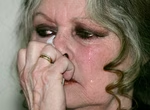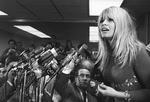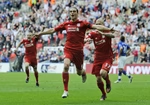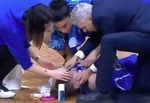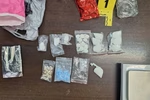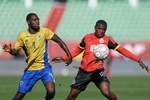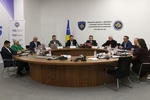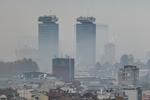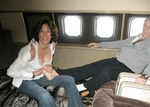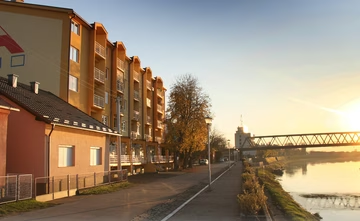
Serbia's police intervened inside the state RTS television building late on Saturday by dragging people out by force. Those who were standing were pushed out, while those who set down, were dragged one by one. Policemen were not seen using clubs.
Outside the building, citizens gathered to protest the actions of the police, chanting "He (Vucic) is finished," a famous slogan during the successful popular protest against Serbia's late strongman Slobodan Milosevic. They also sang Serbia's national anthem and songs about Kosovo. They were sitting on the ground face to face with riot police who remained calm but stood in front of the entrance in large numbers.
However, the situation seems to be on the verge of escalating.
Amid the protest inside the TV building, RTS aired a live news conference by Nebojsa Stefanovic, the Interior Minister, who accused the demonstrators of violence, threatening the journalists, demolishing the premises RTS and violating laws. He said the state would respond by prosecuting every single citizen who had violated the law by entering the building.
He asked the protesters to leave the building peacefully. They said they would not leave before getting some air time live. Soon afterwards, police intervened.
Cameras and mobile phones inside the TV building did not record any violence before the police intervention.
The Belgrade Blic daily published a photo of broken glass at the TV entrance, saying it happened during the attempt by the protesters to enter the building, adding they threatened the security staff with loss of jobs.
Other opposition leaders and MPs joined opposition leader Bosko Obradovic and the protesters as well.
While they were calling on the RTS director Dragan Bujosevic to resign, asking for five minutes during the RTS main evening news and chanting "Vucic, thief," the police arrived at the scene outside the building but did not react at first.
The organisers said the police intervened later on a lower floor of the RTS and even "chocked" one of the demonstrators.
Obradovic who said they have been asking for three months for a few minutes of air time during the main news, but did not get it.
"The security let us in. They stood with the people. We don't want to demolish anything, we don't want to steal, we ask for one thing only - a live appearance of an organiser, not a politician or MP - during the main news," Obradovic said."
After a few protests, President Aleksandar Vucic said people could demonstrate as long as they wished, but that any violence would not be tolerated.
Last Saturday they organised the same event for an hour but did not enter the building. They demanded the resignation of the RTS management, saying they report on political issues, including the protests, as the government mouthpiece although all citizens partly finance them as a public broadcaster.
At the start of the 15th protest, Sinisa Kovacevic, the best known contemporary playwriter, and the deputy leader of the Popular Party told the crowd at the start of the 15th anti-government rally in Belgrade, the regime split people fueling hatred and added that if “a drop of blood falls it will be on Vucic's hands.
In a political radicalisation of the protests last Tuesday, the opposition parties gave the government and president a 30-day deadline to step down or face a large-scale rally in Belgrade on April 13.
“We want elections at all levels within six to nine months during which the media would be free and other opposition demands for fair elections are met,” the opposition said.
Authorities did not comment on the opposition demands for the resignations of Vucic, Prime Minister Ana Brnabic and Parliament Speaker Maja Gojkovic.
“If we don’t win on April 13, we won’t exist,” Kovacevic told the crowd, receiving a huge round of applause. “Vucic must go,” he said, adding the Kosovo issue could not be solved with him in power.
On Friday, the rallies were held in over 20 places across the country. They became regular in some 100 cities and towns, held on Thursdays, Fridays and Saturdays, according to to the organisers.
As of recently, the protesters in some places first listened to speeches by politicians, while before, the speakers included, actors, professors, academicians and common citizens.
The protest walks commonly followed the speeches. The demands were mostly the same: Vucic’s resignation, fair elections, free media, and some local requests for dismissals of SNS officials.
The demonstrations started last November after an opposition leader, Borko Stefanovic, was heavily beaten up by thugs with metal bars ahead of the Alliance for Serbia (SzS) opposition grouping rally in the central town of Krusevac.
The next day, the first protest was held in Belgrade under the “Stop bloody shirts" slogan. Since December 8, they became regular under a new slogan. After Vucic said he wouldn’t cede to the demands even if five million people protested, the rallies were renamed into #1 in 5 million.
So far, Vucic mainly ignored the protests, saying the opposition was behind them and offered them a fresh election where they could measure their strength, though the opposition leaders did not ask for any vote and the majority of the parties said they would boycott it if held according to the current rules.
Meanwhile, in what seems to be Vucic’s answer to the escalation, he launched The Future of Serbia campaign, touring different districts and presenting the people with all the achievement under his rule and with what was wrong with the previous regime, whose leaders now joined the protests.
He denied the campaign was presidential or an election activity. His SNS party hasn’t yet held a previously announced session where it was to decide whether to ask Vucic to call for an early election, with many of high-ranking officials in favour.
Kakvo je tvoje mišljenje o ovome?
Učestvuj u diskusiji ili pročitaj komentare





 Srbija
Srbija
 Hrvatska
Hrvatska
 Slovenija
Slovenija















